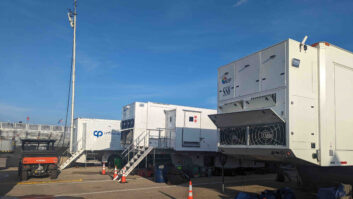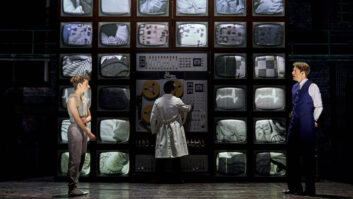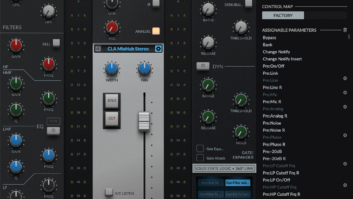Jim Wirt at his Neve 8108 in Crushtone Studios, ClevelandThe talents of Jim Wirt give him perspective on nearly every angle of the music recording business—musician, artist, writer, performer, engineer, producer and record company owner—and his career path translates his unique vibe of rock and roll authenticity with a solid academic base.

With Bachelor degrees in both Music Theory and Music Education from Drury University, Jim began as a focused rock-bassist and achiever transplanted from Springfield, MI to Santa Monica, CA, soon to find solid footing in the 1990s LA recording scene. Today, Wirt resides in Cleveland, working out of his own analogcentric recording facility, Crushtone Studios (crushtonestudios.com), featuring a Neve 8108 tracking console and 72-channel Solid Stage Logic with “Brown-knob” EQs and Ultimation.
“I got into the recording business because I was really concerned with making my band sound good,” recalls Wirt. “Of course, I hunkered down and learned , then eventually quit the band because I was too busy recording. I backed into it all without really knowing what I was getting myself into and have done it ever since.”
The key component of Wirt’s production acumen has always been his musicality. As a college string major with a solid music theory base, Wirt “could basically play everything” necessary in rock production, and more. “I could always sing and play, and I was always in bands,” Wirt explains. “Though I [mainly] played bass, I could play violin and cello, guitar, piano, even drums.”
Today, Wirt is known for his writing and musicianship, having added performances, collaborative writing and some deep string arrangements to his 11 Gold- and Platinum-certified album discography. It’s no wonder, considering his artistic approach to engineering and production, that he started this way: “In Springfield, my hometown, there was a studio with a 2-inch analog recorder,” he explains. “The owner was technically minded and not so much musically minded. It was frustrating working with him. So I and another guy in the band really tried to learn how to record ourselves. Eventually I landed a good summer job to amass some money, bought into the 8-track stuff, and recorded other bands at my house.”
How important is it to be musical when you’re an engineer/producer? “I think it’s important, but I don’t think it’s completely necessary,” proves Wirt as he responds with a list of his favorite non-musician super-mixers. “But when you’re working with younger bands or those that aren’t as good, you’ll probably play on the records. I believe in bands. They have a sound. If [the bands] come to me and ask me to play keyboard parts, I’ll definitely do that, but I try to avoid as much as possible playing people’s parts.”
With modern digital recording technology offering essentially limitless options, Wirt lives as an artistic professional conflicted by the universal access of such tools. As such, he tends to emphasize traditional production techniques—careful microphone placement and application of effects, for example. “When we started out, you filled up that 24-track tape and you were done, one way or another,” Wirt explains. “If you were going to do extensive background vocals, you had to plan for that; you’d do drums then bounce them down to two tracks so you could do the BGVs. Nowadays, you don’t have to plan things. But having worked with tape, making sure that essentials were done in order of priority, was good practice. Now we can layer for days and days and eventually it doesn’t sound like anything.”
Wirt argues that in many cases, it’s technology influencing the music. “Musically, there is a finite set of options, really. After that, you’re just covering it with technology. I think limitations can be good.”
Wirt began coming to Cleveland to record his “East Coast bands” at the now-shuttered Closer Look Studios, eventually moving entirely from Santa Monica to merge Closer Look’s equipment with a new loft-style recording space with raw wood floors. “We just did it,” he says enthusiastically of the beautiful, open Crushtone space. “For one thing, the rent for 10,000 square feet is about the same as we spent for 200 square feet in Santa Monica. So you can’t do a studio like this in some areas, obviously. It’s a different space, too. For the drum room, the walls don’t go all the way up [to the ceiling]. That allowed for a ‘dead’ space to do drums while putting mics on the outside of the wall, keeping the cymbal sound tight while keeping the overhead sound out of the room mics, for example.”
Most importantly, Wirt emphasizes that the key components of music producers reside in their social abilities and the skill of coaxing performances from artists. “It’s about dealing with people,” he offers. “I think a lot of technical people become technical because they don’t like dealing with people. But having good people skills, being sensitive to people and knowing whether they need nurturing or an ass-kicking are skills that I have, and that ultimately makes a great record.”
Crushtone Studios
crushtonestudios.com



